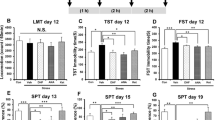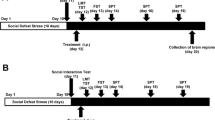Abstract
Rationale
(R,S)-ketamine, an N-methyl-D-aspartate receptor (NMDAR) antagonist, exhibits rapid and long-lasting antidepressant effects and anti-suicidal ideation in treatment-resistant patients with depression. However, the precise mechanisms underlying the antidepressant actions of (R,S)-ketamine are unknown. Although the previous report demonstrated the deuterium isotope effects in the antidepressant actions of (R,S)-ketamine, the deuterium isotope effects in the antidepressant actions of (R)-ketamine, which is more potent than (S)-ketamine, are unknown.
Methods
We examined whether deuterium substitution at the C6 position could affect antidepressant effects of (R)-ketamine in a chronic social defeat stress (CSDS) model.
Results
Pharmacokinetic studies showed that levels of (2R,6R)-d1-hydroxynorketamine [(2R,6R)-d1-HNK], a final metabolite of (R)-d2-ketamine, in the plasma and brain after administration of (R)-d2-ketamine (10 mg/kg) were lower than those of (2R,6R)-HNK from (R)-ketamine (10 mg/kg), indicating deuterium isotope effects in the production of (2R,6R)-HNK. In contrast, levels of (R)-ketamine and its metabolite (R)-norketamine in the plasma and brain were the same for both compounds. In a CSDS model, both (R)-ketamine (10 mg/kg) and (R)-d2-ketamine (10 mg/kg) showed rapid and long-lasting (7 days) antidepressant effects, indicating no deuterium isotope effect in the antidepressant effects of (R)-ketamine.
Conclusions
The present study suggests that deuterium substitution of hydrogen at the C6 position slows the metabolism from (R)-ketamine to (2R,6R)-HNK in mice. In contrast, we did not find the deuterium isotope effects in terms of the rapid and long-lasting antidepressant effects of (R)-ketamine in a CSDS model. Therefore, it is unlikely that (2R,6R)-HNK is essential for antidepressant effects of (R)-ketamine.



Similar content being viewed by others
References
Abdallah CG (2017) What’s the buzz about hydroxynorketamine? Is it the history, the story, the debate, or the promise? Biol Psychiatry 81:e61–e63
Berman RM, Cappiello A, Anand A, Oren DA, Heninger GR, Charney DS, Krystal JH (2000) Antidepressant effects of ketamine in depressed patients. Biol Psychiatry 47:351–354
Chaki S (2017) Beyond ketamine: new approaches to the development of safer antidepressants. Curr Neuropharmacol 15:963–976
Chaki S (2018) Is metabolism of (R)-ketamine essential for the antidepressant effects? Int J Neuropsychopharmacol 21:154–156
Chang L, Toki H, Qu Y, Fujita Y, Mizuno-Yasuhira A, Yamaguchi JI, Chaki S, Hashimoto K (2018) No sex-specific differences in the acute antidepressant actions of (R)-ketamine in an inflammation model. Int J Neuropsychopharmacol. https://doi.org/10.1093/ijnp/pyy053
Desta Z, Moaddel R, Ogburn ET, Xu C, Ramamoorthy A, Venkata SL, Sanghvi M, Goldberg ME, Torjman MC, Wainer IW (2012) Stereoselective and regiospecific hydroxylation of ketamine and norketamine. Xenobiotica 42:1076–1087
Diazgranados N, Ibrahim L, Brutsche NE, Newberg A, Kronstein P, Khalife S, Kammerer WA, Quezado Z, Luckenbaugh DA, Salvadore G, Machado-Vieira R, Manji HK, Zarate CA Jr (2010) A randomized add-on trial of an N-methyl-D-aspartate antagonist in treatment-resistant bipolar depression. Arch Gen Psychiatry 67:793–802
Duman RS, Aghajanian GK, Sanacora G, Krystal JH (2016) Synaptic plasticity and depression: new insights from stress and rapid-acting antidepressants. Nat Med 22:238–249
Foster AB (1984) Deuterium isotope effects in studies of drug metabolism. Trends Pharmacol Sci 5:524–527
Fukumoto K, Toki H, Iijima M, Hashihayata T, Yamaguchi JI, Hashimoto K, Chaki S (2017) Antidepressant potential of (R)-ketamine in rodent models: comparison with (S)-ketamine. J Pharmacol Exp Ther 361:9–16
Garay R, Zarate CA Jr, Cavero I, Kim YK, Charpeaud T, Skolnick P (2018) The development of glutamate-based antidepressants is taking longer than expected. Drug Discov Today. https://doi.org/10.1016/j.drudis.2018.02.006
Hashimoto K (2016a) R-ketamine: a rapid-onset and sustained antidepressant without risk of brain toxicity. Psychol Med 46:2449–2451
Hashimoto K (2016b) Ketamine’s antidepressant action: beyond NMDA receptor inhibition. Expert Opin Ther Targets 20:1389–1392
Hashimoto K (2016c) Detrimental side effects of repeated ketamine infusions in the brain. Am J Psychiatry 173:1044–1045
Hashimoto K, Shirayama Y (2018) What are the causes for discrepancies of antidepressant actions of (2R,6R)-hydroxynorketamine? Biol Psychiatry 84:e7–e8
Hashimoto K, Inoue O, Suzuki K, Yamasaki T, Kojima M (1986) Deuterium isotope effect of [11C]N,N-dimethylphenethylamine-α,α-d2: reduction in metabolic trapping rate in brain. Int J Rad Appl Instrum B 13:79–80
Hashimoto K, Kakiuchi T, Ohba H, Nishiyama S, Tsukada H (2017) Reduction of dopamine D2/3 receptor binding in the striatum after a single administration of esketamine, but not R-ketamine: a PET study in conscious monkeys. Eur Arch Psychiatry Clin Neurosci 267:173–176
Hijazi Y, Boulieu R (2002) Contribution of CYP3A4, CYP2B6, and CYP2C9 isoforms to N-demethylation of ketamine in human liver microsomes. Drug Metab Dispos 30:853–858
Kavalali ET, Monteggia LM (2015) How does ketamine elicit a rapid antidepressant response? Curr Opin Pharmacol 20:35–39
Kishimoto T, Chawla JM, Hagi K, Zarate CA, Kane JM, Bauer M, Correll CU (2016) Single-dose infusion ketamine and non-ketamine N-methyl-D-aspartate receptor antagonists for unipolar and bipolar depression: a meta-analysis of efficacy, safety and time trajectories. Psychol Med 46:1459–1472
Krystal JH, Sanacora G, Duman RS (2013) Rapid-acting glutamatergic antidepressants: the path to ketamine and beyond. Biol Psychiatry 73:1133–1141
Monteggia LM, Zarate CA Jr (2015) Antidepressant actions of ketamine: from molecular mechanisms to clinical practice. Curr Opin Neurobiol 30:139–143
Murrough JW, Iosifescu DV, Chang LC, Al Jurdi RK, Green CE, Perez AM, Iqbal S, Pillemer S, Foulkes A, Shah A, Charney DS, Mathew SJ (2013) Antidepressant efficacy of ketamine in treatment-resistant major depression: a two-site randomized controlled trial. Am J Psychiatry 170:1134–1142
Newport DJ, Carpenter LL, WM MD, Potash JB, Tohen M, Nemeroff CB, APA Council of Research Task Force on Novel Biomarkers and Treatments (2015) Ketamine and other NMDA antagonists: early clinical trials and possible mechanisms in depression. Am J Psychiatry 172:950–966
Sanacora G, Frye MA, McDonald W, Mathew SJ, Turner MS, Schatzberg AF, Summergrad P, Nemeroff CB, American Psychiatric Association (APA) Council of Research Task Force on Novel Biomarkers and Treatments (2017) A consensus statement on the use of ketamine in the treatment of mood disorders. JAMA Psychiatry 74:399–405
Shirayama Y, Hashimoto K (2017) Effects of a single bilateral infusion of R-ketamine in the rat brain regions of a learned helplessness model of depression. Eur Arch Psychiatry Clin Neurosci 267:177–182
Shirayama Y, Hashimoto K (2018) Lack of antidepressant effects of (2R,6R)-hydroxynorketamine in a rat learned helplessness model: comparison with (R)-ketamine. Int J Neuropsychopharmacol 21:84–88
Short B, Fong J, Galvez V, Shelker W, Loo CK (2018) Side-effects associated with ketamine use in depression: a systematic review. Lancet Psychiatry 5:65–78
Singh I, Morgan C, Curran V, Nutt D, Schlag A, McShane R (2017) Ketamine treatment for depression: opportunities for clinical innovation and ethical foresight. Lancet Psychiatry 4:419–426
Tian Z, Dong C, Fujita A, Fujita Y, Hashimoto K (2018) Expression of heat shock protein HSP-70 in the rerosplenial cortex of rat brain after administration of (R,S)-ketamine and (S)-ketamine, but not (R)-ketamine. Pharmacol Biochem Behav 172:17–21
Toki H, Ichikawa T, Mizuno-Yasuhara A, Yamaguchi JI (2018) A rapid and sensitive chiral LC-MS/MS method for the determination of ketamine and norketamine in mouse plasma, brain and cerebrospinal fluid applicable to the stereoselective pharmacokinetic study of ketamine. J Pharm Biomed Anal 148:288–297
Wiberg KB (1955) The deuterium isotope effect. Chem Rev 55:713–743
Wilkinson ST, Toprak M, Turner MS, Levine SP, Katz RB, Sanacora G (2017) A survey of the clinical, off-label use of ketamine as a treatment for psychiatric disorders. Am J Psychiatry 174:695–696
Wilkinson ST, Ballard ED, Bloch MH, Mathew SJ, Murrough JW, Feder A, Sos P, Wang G, Zarate CA Jr, Sanacora G (2018) The effect of a single dose of intravenous ketamine on suicidal ideation: a systematic review and individual participant data meta-analysis. Am J Psychiatry 175:150–158
World Health Organization (WHO) Depression (2018) Available at www.who.int/news-room/fact-sheets/detail/depression
Xu Y, Hackett M, Carter G, Loo C, Gálvez V, Glozier N, Glue P, Lapidus K, McGirr A, Somogyi AA, Mitchell PB, Rodgers A (2016) Effects of low-dose and very low-dose ketamine among patients with major depression: a systematic review and meta-analysis. Int J Neuropsychopharmacol 19:pyv124
Yamaguchi J, Toki H, Qu Y, Yang C, Koike H, Hashimoto K, Mizuno-Yasuhira A, Chaki S (2018) (2R,6R)-Hydroxynorketamine is not essential for the antidepressant actions of (R)-ketamine in mice. Neuropsychopharmacology 43:1900–1907
Yang C, Shirayama Y, Zhang JC, Ren Q, Yao W, Ma M, Dong C, Hashimoto K (2015) R-ketamine: a rapid-onset and sustained antidepressant without psychotomimetic side effects. Transl Psychiatry 5:e632
Yang C, Han M, Zhang JC, Ren Q, Hashimoto K (2016) Loss of parvalbumin-immunoreactivity in mouse brain regions after repeated intermittent administration of esketamine, but not R-ketamine. Psychiatry Res 239:281–283
Yang C, Qu Y, Abe M, Nozawa D, Chaki S, Hashimoto K (2017a) (R)-ketamine shows greater potency and longer lasting antidepressant effects than its metabolite (2R,6R)-hydroxynorketamine. Biol Psychiatry 82:e43–e44
Yang C, Qu Y, Fujita Y, Ren Q, Ma M, Dong C, Hashimoto K (2017b) Possible role of the gut microbiota-brain axis in the antidepressant effects of (R)-ketamine sin a social defeat stress model. Transl Psychiatry 7:1294
Yang C, Ren Q, Qu Y, Zhang JC, Ma M, Dong C, Hashimoto K (2018) Mechanistic target of rapamycin-independent antidepressant effects of (R)-ketamine in a social defeat stress model. Biol Psychiatry 83:18–28
Zanos P, Gould TD (2018) Mechanisms of ketamine action as an antidepressant. Mol Psychiatry 23:801–811
Zanos P, Moaddel R, Morris PJ, Georgiou P, Fischell J, Elmer GI, Alkondon M, Yuan P, Pribut HJ, Singh NS, Dossou KS, Fang Y, Huang XP, Mayo CL, Wainer IW, Albuquerque EX, Thompson SM, Thomas CJ, Zarate CA Jr, Gould TD (2016) NMDAR inhibition-independent antidepressant actions of ketamine metabolites. Nature 533:481–486
Zanos P, Moaddel R, Morris PJ, Riggs LM, Highland JN, Georgiou P, Pereira EFR, Albuquerque EX, Thomas CJ, Zarate CA Jr, Gould TD (2018) Ketamine and ketamine metabolite pharmacology: insights into therapeutic mechanisms. Pharmacol Rev 70:621–660
Zarate CA Jr, Singh JB, Carlson PJ, Brutsche NE, Ameli R, Luckenbaugh DA, Charney DS, Manji HK (2006) A randomized trial of an N-methyl-D-aspartate antagonist in treatment-resistant major depression. Arch Gen Psychiatry 63:856–864
Zarate CA Jr, Brutsche NE, Ibrahim L, Franco-Chaves J, Diazgranados N, Cravchik A, Selter J, Marquardt CA, Liberty V, Luckenbaugh DA (2012) Replication of ketamine’s antidepressant efficacy in bipolar depression: a randomized controlled add-on trial. Biol Psychiatry 72:331–338
Zhang JC, Li SX, Hashimoto K (2014) R(-)-ketamine shows greater potency and longer lasting antidepressant effects than S(+)-ketamine. Pharmacol Biochem Behav 116:137–141
Zhang K, Dong C, Fujita Y, Fujita A, Hashimoto K (2018a) 5-Hydroxytryptamine-independent antidepressant actions of (R)-ketamine in a chronic social defeat stress model. Int J Neuropsychopharmacol 21:157–163
Zhang K, Fujita Y, Hashimoto K (2018b) Lack of metabolism in (R)-ketamine’s antidepressant actions in a chronic social defeat stress model. Sci Rep 8:4007
Zhang K, Ma M, Dong C, Hashimoto K (2018c) Role of inflammatory bone markers in the antidepressant actions of (R)-ketamine in a chronic social defeat stress model. Int J Neuropsychopharmacol. https://doi.org/10.1093/ijnp/pyy065
Funding
This study was supported by AMED (to K.H., JP18dm0107119).
Author information
Authors and Affiliations
Corresponding author
Ethics declarations
Conflict of interest
Dr. Hashimoto is an inventor on a filed patent application on “The use of (R)-ketamine in the treatment of psychiatric diseases” by Chiba University. Dr. Hashimoto has received research support from Dainippon-Sumitomo, Otsuka, and Taisho. Drs. Toki, Mizuno-Yasuhira, Yamaguchi, and Chaki are employee of Taisho Pharmaceutical Co., Ltd., Japan. Other authors declare no conflict of interest.
Rights and permissions
About this article
Cite this article
Zhang, K., Toki, H., Fujita, Y. et al. Lack of deuterium isotope effects in the antidepressant effects of (R)-ketamine in a chronic social defeat stress model. Psychopharmacology 235, 3177–3185 (2018). https://doi.org/10.1007/s00213-018-5017-2
Received:
Accepted:
Published:
Issue Date:
DOI: https://doi.org/10.1007/s00213-018-5017-2




